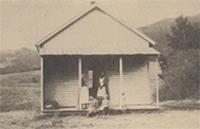Going to School in Santa Cruz County
In the bicentennial year of 1976, with everyone focused on the history of our country, the Santa Cruz County Office of Education led by County Superintendent of Schools Richard R. Fickel decided to research and publish a book of the history of Santa Cruz County schools. Researching and compiling all the pictures and information took two years and the concerted effort of many in the community and at the County Office of Education. Margaret Koch, author of a number of history books on Santa Cruz, was commissioned to write the manuscript.
Only five of these books exist in our office. In an effort to preserve this document and to provide it as a reference to teachers, students, and others, the County Office of Education has scanned the book. A copy may be downloaded here. The book not only contains information on many of the early schools but has an array of old photos. Research for the book included using other books about Santa Cruz County, searching the archives of the Santa Cruz Sentinel, the Register Pajaronian, yearbooks, and using personal interviews.
Chapter II begins the tale with the Ohlone Indians and the lessons they taught to their children. Then late in the 1700’s came the arrival of the white man and the Santa Cruz Mission. It was the intention of the missionaries to educate the Indians but only a few did actually learn to read and write. By 1847, the first families started to arrive in the county and children were gathered in homes to be taught, but only during the summer months.
Santa Cruz County was officially created on February 18, 1850, seven months before California became a part of the United States. In 1854, the tax rate for schools was set at five cents for every $100 of taxable property. Schools, both public and Christian continued to grow housed in private homes and churches. Finally in 1857 the first public one-room schoolhouse was built near Mission Hill at a cost of $2,233. It was named Santa Cruz District 1. Over the next four years, five more schools were built. As time went on, the first schoolhouse was expanded to accommodate ever-increasing numbers of students. It was replaced in 1879 with a more modern multi-leveled building. Appendix B gives a chronological listing of the formation of schools throughout the County.

Rare photograph of a “ranch school.”
A number of today’s schools were named after early educators. Two such schools are Mintie White Elementary and MacQuiddy Elementary. Arminta Allison White, better known as Mintie White, was only four years old when her parents traveled from Iowa to Vacaville, California. When her daughter developed tuberculosis, the family moved to Watsonville for the climate. After the death of her daughter and then her husband shortly thereafter, Ms. White went back to school to obtain her teaching credential. At age 45 she became a first grade teacher at Watsonville Primary School. Although offered the position of principal, she devoted her entire teaching career to first graders. Her favorite saying was, “I never knew a child I couldn’t love.”
During his 43 years as an educator, Thomas MacQuiddy served as teacher, principal, and superintendent of Watsonville High School. He began his career teaching science and mathematics in 1905. Two years later he was appointed to the post of principal and superintendent. He carried out these duties while remaining in the classroom. To read more about these outstanding educators see Chapter VIII.
We have also scanned a School Manual for the County of Santa Cruz for the year 1933. Check out the Childrens’ Code of Morals on page 23 and the Suggestions to Teachers on page 65.
